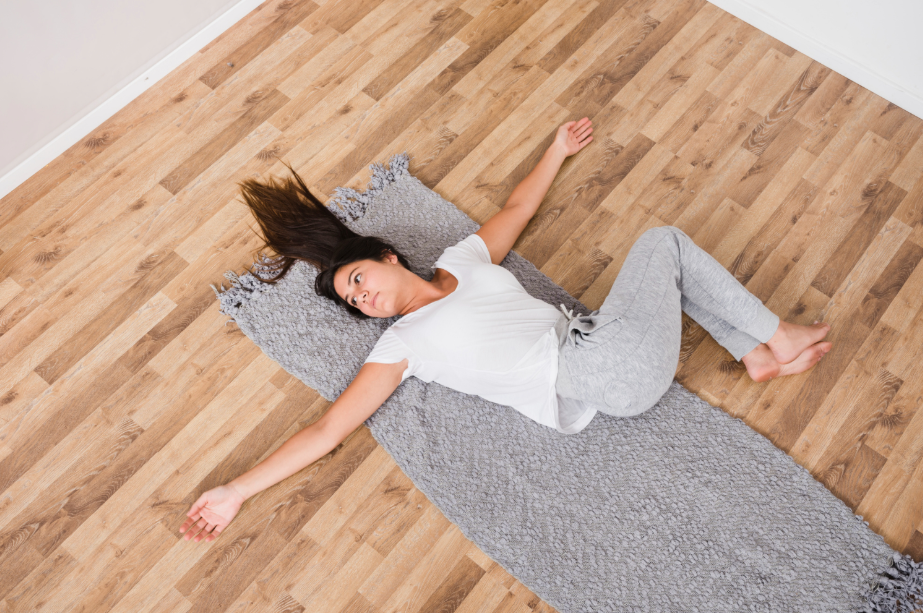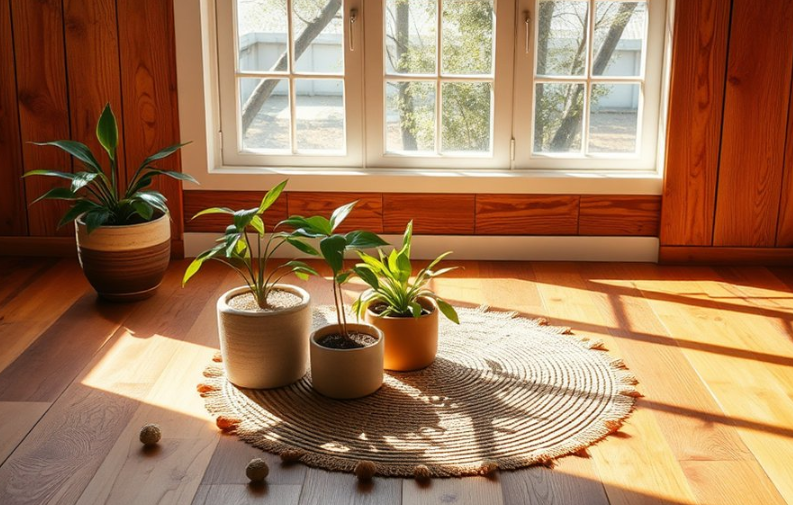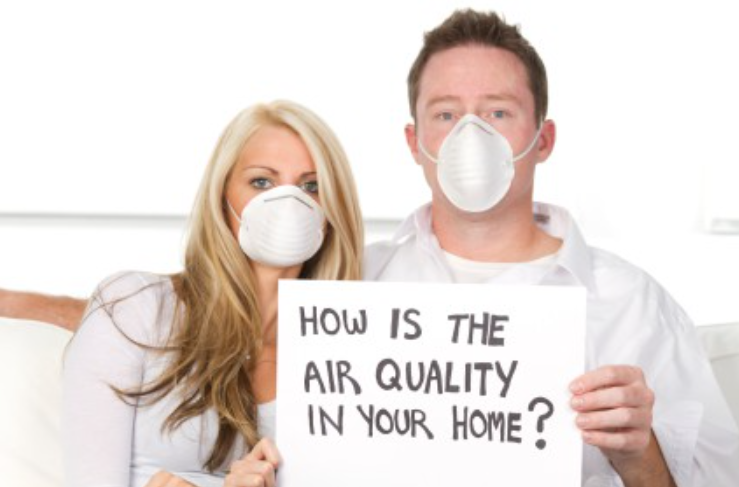Why Non-Toxic Laminate Flooring Recommended For Families With Allergies And Children
Non-toxic laminate flooring is the best choice for families with allergies, asthma, or young children. It cuts down on common health risks in your home. The smooth, non-porous surface stops allergens like dust mites, pet dander, and bacteria from getting trapped. Carpet holds these particles deep in its fibers. Laminate doesn’t. This makes cleaning much easier. You can keep allergy triggers off the floor and out of the air.
Health Benefits for Sensitive Groups
Infants and toddlers are most at risk. They spend a lot of time crawling or playing on the floor.
Children and adults with asthma or allergies get relief from fewer airborne triggers. They also face less chemical exposure.
People with weak immune systems face fewer health problems from chemical off-gassing.
Reduced Chemical Exposure
Based on my experience, many non-toxic laminate options use formaldehyde-free adhesives. These are often water-based glues instead of urea-formaldehyde. This cuts down the off-gassing of harmful volatile organic compounds (VOCs). Here are some numbers:
Premium non-toxic laminate brands can have VOC emissions as low as <9 ng/m³. Standard laminate may reach up to 0.03 ppm.
This drop means better air quality in your home. You can measure the difference.
Certifications that Matter
- GREENGUARD Gold
- FloorScore
- CARB compliance
Risks of Standard Laminate Flooring
Standard laminate flooring without third-party certification can emit VOCs and other harmful chemicals. This can last for several weeks after you install it. Health risks include:
Short-term: Eye, nose, and throat irritation. Headaches and breathing problems. Children and sensitive people see these effects more often.
Long-term: Higher cancer rates (6–30 extra cases per 100,000 people with continuous heavy exposure). There are also possible nervous system and reproductive health issues.
Health Benefits of Non-Toxic Laminate Flooring
Lower VOC and Formaldehyde Emissions
Ultra-low VOC emissions: Top brands report VOC emissions as low as <9 ng/m³. Standard laminates can reach 0.03 ppm or more.
Reduced Formaldehyde risk: Non-toxic laminates use formaldehyde-free or water-based adhesives. Conventional options use urea-formaldehyde. This cuts the danger of headaches and breathing problems. It also reduces potential long-term cancer risk. According to CDC data, high-formaldehyde flooring may lead to 6–30 extra cancer cases per 100,000 with constant exposure.
Protection for Children and Sensitive Groups
Healthier spaces for infants, toddlers, and allergy sufferers: Kids are more vulnerable to chemical emissions and allergens. So are people with asthma, immune problems, and even pets. Non-toxic flooring reduces these hazards. It creates safer ground for crawling, playing, and breathing.
Prevention of allergens: The smooth, non-porous surface does not trap dust mites, pet dander, or mold. I find it much more hypoallergenic than carpeting.
Improved Indoor Air Quality
Certified air quality: Products that meet certifications such as GREENGUARD Gold, floorscore®, and CARB compliance ensure minimal off-gassing. This creates better air for the whole family. This is key in homes with sensitive individuals.
Quicker and Safer Room Use
Fast move-in, no lingering odors: With low- and no-VOC formulas, non-toxic laminates produce little to no odor after installation. Rooms can be occupied sooner. This provides peace of mind for parents.
At-a-Glance Comparison and Examples
| Product Type | VOC/Formaldehyde Emissions | Adhesive/Binder | Certifications |
|---|---|---|---|
| Non-Toxic Laminate | <9 ng/m³ | No formaldehyde, water-based | GREENGUARD, FloorScore® |
| Conventional Laminate | Up to 0.03 ppm or more | Urea-formaldehyde | Varies, not always present |
Mohawk: Non-toxic laminate, VOC emissions <9 ng/m³
Pergo: Non-toxic lines start at $1.79/sq ft
Quick-Step: Premium non-toxic laminate up to $4.09/sq ft
Key Features of Non-Toxic Laminate Flooring for Allergies and Children
Non-toxic laminate flooring focuses on safety and health benefits.
Ultra-Low VOC and Formaldehyde Emissions
Leading brands achieve VOC levels as low as or even lower than natural wood.
Certifications like M1 (Finland), A+ (France), GREENGUARD Gold, FloorScore®, and EPD guarantee minimal indoor air pollution.
GreenGuard Gold Certified laminate releases no more than 0.0073 ppm formaldehyde. This is well below legal or outdoor levels.
Safe Core, Adhesives & Materials
These floors use formaldehyde-free or no-added urea-formaldehyde (NAUF) glues. This keeps the air safer.
HDF (high-density fiberboard) cores contain natural wood fibers with the safest binders.
Some brands add plant fibers or polystyrene (e.g., Mohawk, Duravana) for waterproofing. Emissions do not increase.
No PVC, phthalates, or plasticizers. This lowers chemical risk for sensitive groups.
Waterproof and Safe for Allergies
Advanced coatings and sealed edges add waterproofing. They improve hygiene by resisting mold and bacteria.
Odorless. No substances trigger allergies or chemical sensitivities.
Extra Durability and Child Safety
Durable surfaces have scratch-resistant layers (like TitanX™ and AquaSafe). They provide safe, long-lasting areas for children to play.
Surfaces withstand wear without hurting indoor air quality.
Strict Certifications and International Standards
Look for proof of compliance: E1, E0, CARB2, TSCA Title VI.
European standards: E1 allows ≤0.1 ppm formaldehyde. E0 is even stricter.
Many products exceed these baselines. This ensures much cleaner indoor air.
Brand and Product Examples
Mohawk: Formaldehyde-free, ultra-low VOC, and GREENGUARD Gold certified.
Kahrs: Uses HDF Core and formaldehyde-free adhesives.
BAIER FLOOR: Lines with no added formaldehyde.
Tarkett: Invitation Collection is formaldehyde-free.
Duravana (LL Floors): Features plant-fiber and polystyrene core. GREENGUARD Gold certified.
Clapton by Inhaus: No PVC or phthalates. Low emission. Mold-and-bacteria resistant.
Leading Swedish and German brands meet or exceed E0/E1 benchmarks.
Industry Data
- Top non-toxic laminates: Formaldehyde emissions are below 0.0073 ppm (GREENGUARD Gold). This is far safer than older products and most outdoor environments.
- NAUF hardwood technology: Achieves 90% lower formaldehyde emissions than traditional materials.
Health Consequences of VOC Exposure from Laminate Flooring
Certain laminate flooring and adhesives release volatile organic compounds (VOCs). This is a well-documented health hazard. Homes with children, allergy sufferers, or people sensitive to air quality face the biggest risks.
Short-Term Health Effects of VOCs
Eye, nose, and throat irritation
Headaches, dizziness, and fatigue
Coughing, wheezing, and respiratory distress
Skin irritation and rashes
Heightened allergy and asthma symptoms
Children and older adults often notice problems after new laminate floors are installed. Mild headaches or breathing issues appear within days.
Long-Term and Chronic Health Risks
Increased risk of rare cancers:
Continuous exposure to high-formaldehyde floors may lead to an estimated 6–30 additional cancer cases per 100,000 people over two years.
Potential nervous system impact:
Indoor VOC levels at 25,000 µg/m³ can cause neurotoxic symptoms. Ongoing headaches become a problem at these concentrations.
Higher risk of developing sensitivities:
Extended contact worsens allergies. It can also cause new sensitivities in both adults and children.
Children and Sensitive Groups: Special Risks
Infants, young children, and those with weakened lungs or immune systems face the most risk.
They develop symptoms at much lower VOC concentrations than healthy adults.
Symptoms often improve after leaving the home.
This links health issues directly to indoor contaminants.
Primary VOC Sources in Laminate Flooring
Adhesives and glues containing formaldehyde
Surface coatings and finishes with chemical off-gassing
Off-gassing from synthetic board fillers and wood degradation
VOC emissions peak right after installation. They decline over two years but may remain elevated for sensitive people.
Notable VOC Examples and Real-World Impact
Formaldehyde: A known Group 1 human carcinogen. Standard laminate adhesives and composite materials contain this compound.
Indoor VOC levels surpass those found outdoors. People spend 90% of their time inside. Cumulative risk grows because of this.
Children in homes with high-VOC flooring face greater odds of chronic respiratory symptoms. Their lifetime cancer risk exceeds that of peers in healthier air environments.
Typical Warning Signs
Strong chemical odors after installation
Coughing, eye or throat irritation, or headaches that occur at home but not elsewhere
Quick Reference: Health Impact Table
| Health Effect Category | Example Symptoms | At-Risk Groups | Key VOCs |
|---|---|---|---|
| Acute Irritation | Eye, nose, throat irritation; headaches | Children, older adults, asthmatics | Formaldehyde, other VOCs |
| Respiratory Issues | Cough, worsened asthma | Allergy/respiratory problem sufferers | Formaldehyde |
| Neurological | Headaches, neurotoxic symptoms | Everyone, sensitive people at higher risk | High VOCs |
| Allergic/Immune | Aggravated allergies, skin irritation | Allergy-prone individuals | Generic VOCs |
| Carcinogenic (chronic exposure) | Elevated cancer risk | Long-term residents | Formaldehyde |
Performance and Durability of Non-Toxic Laminate Flooring
Non-toxic laminate flooring uses smart engineering and strict health standards. It offers a strong and safe choice for families. I recommend it for those with allergies or young children.
Engineered for Strength and Indoor Safety
Core material: The core uses high-density fiberboard (HDF) or solid wood. No added formaldehyde. This keeps indoor air safe. It also maintains structural stability.
Adhesives: Manufacturers use water-based, formaldehyde-free glues. This cuts chemical exposure. It also strengthens product quality.
Top layer: A tough melamine resin surface provides scratch, scuff, and stain resistance. I find it ideal for high-traffic homes.
Key Performance Features
VOC emissions: Top brands like Mohawk RevWood, Pergo, and Newton offer VOC emissions under 9 ng/m³. This is far safer than conventional choices at up to 0.03 ppm.
Scratch and wear resistance: Certified brands use reinforced wear layers. Many include aluminum oxide finishes. Based on my experience, this protection matches or beats standard laminates.
Water resistance: Products like Newton Clearwater include water-repellent waxes and plastics. They are highly moisture-resistant. This is crucial for active families and homes with allergy concerns.
Longevity and Low Maintenance
Typical lifespan: High-quality laminate lasts 15–25 years. Some lines like Pergo offer lifetime warranties.
Maintenance: The durable wear layer prevents frequent repairs. Planks can’t be refinished. They need replacing if damaged.
Moisture resistance benefits: Non-toxic products use better construction. This reduces swelling and damage. They even beat budget laminates in this area.
Quick Comparison Table
| Feature | Non-Toxic Laminate | Conventional Laminate |
|---|---|---|
| Core Material | HDF/wood, no added formaldehyde | HDF/wood composite, often urea-formaldehyde |
| VOC Emissions | <9 ng/m³ | Up to 0.03 ppm or more |
| Top Layer | Melamine resin | Melamine resin |
| Scratch Resistance | Excellent with certification | Very good, varies by brand |
| Water Resistance | High (modern/non-toxic lines) | Often high, but can swell if lower quality |
| Warranty | 15–30 years or lifetime | 15–30 years standard |
| Certifications | FloorScore, GREENGUARD, CARB 2, M1 | Varies; not always present |
Certifications and Safety Standards for Non-Toxic Laminate Flooring
Top Indoor Air Quality Certifications
FloorScore® Certification
The flooring industry recognizes FloorScore®. Labs test for formaldehyde, acetaldehyde, and other VOCs. Materials must meet the lowest emission levels based on strict CREL standards. I suggest FloorScore® certified laminate for peace of mind. Your floors won’t add harmful pollutants to your home.
GreenGuard and GreenGuard Gold Certification
GreenGuard certification limits total VOC emissions. GreenGuard Gold sets the bar even lower at just 220 μg/m³. This is ideal for sensitive children and people prone to allergies. I like GreenGuard Gold certified products for schools, healthcare settings, and homes where air quality matters.
EPA TSCA Title VI Compliance
This is a federal benchmark for formaldehyde emissions in composite wood products. TSCA Title VI sets legal maximum limits:
Hardwood plywood: 0.05 ppm
Particleboard: 0.09 ppm
MDF: 0.11 ppm
Thin MDF: 0.13 ppm
Select laminate brands follow these standards. Products must be labeled as compliant.
California CARB Phase 2 Standards
CARB Phase 2 is one of the world’s toughest chemical emission standards. Flooring that passes CARB Phase 2 testing will also meet or exceed EPA rules. Based on my experience, these limits help protect children with allergies. Emissions stay very low.
NALFA LF-01 Indoor Air Quality Standards
Some leading brands, such as Mannington, go further. They use third-party testing through NALFA’s strict LF-01 standard. This confirms minimal impact on indoor air.
Environmental and Health Product Declarations
EPD and HPD Transparency
Environmental Product Declarations (EPDs) and Health Product Declarations (HPDs) give you clarity. You’ll understand a product’s full environmental impact and material ingredients. I recommend choosing flooring with these disclosures. You can see what you’re bringing into your child’s space.
ISO 14001 Manufacturing Certification
Manufacturing plants with ISO 14001 certification show a commitment to environmental improvement. Your laminate flooring comes from facilities where emissions are monitored. They reduce emissions during every production step.
Ultra-Low Emissions and No Added Formaldehyde
NAF (No Added Formaldehyde) flooring brands like Mohawk and Baier use no added formaldehyde technology. This ensures ultra-low VOC emissions. I suggest this for extra-sensitive children and people who suffer from allergies.
Performance Benchmarks
GreenGuard Gold: ≤ 220 μg/m³ total VOCs
Average house: ~150 μg/m³
Outdoor rates: 30–60 μg/m³
GreenGuard Gold certified flooring beats most home and all outdoor benchmarks. It offers healthier air in any room.
Compliance with Green Building Programs
Certified non-toxic laminate flooring products often qualify for LEED v4, WELL, BREEAM, CHPS, and Green Globes credits. These green building programs certify that your choices are safe. They also support wider sustainability goals and healthier living standards for your home and loved ones.
My Top Picks for Non-Toxic Laminate Flooring to Protect Your Kids and Allergies
I recommend laminate flooring with independent certifications like GREENGUARD Gold, FloorScore, or CARB2. These certifications prove the flooring releases very low levels of VOCs and formaldehyde. This makes them safer for households with allergies and young children.
Top Brands I Recommend
Baier Floor
Formaldehyde-free with ultra-low VOC.
Experts rate it as the best for low chemical emissions.
Mohawk publishes transparent VOC emission levels.
Newton
GREENGUARD certified for air quality safety.
Features durable, scratch-resistant surfaces.
Built for active households with kids.
Mannington
Certified by FloorScore and NALFA LF-01.
Meets CARB requirements.
Offers waterproof, ultra-low emission products for allergy-prone homes.
Liberty Home
Has FloorScore certification and CARB compliance.
Uses responsible production methods.
The Independence collection is 100% waterproof and AC4-rated. Perfect for children and pets.
Kahrs and NexxaCore
Both feature formaldehyde-free cores.
Consultants prefer these for hypoallergenic spaces.



